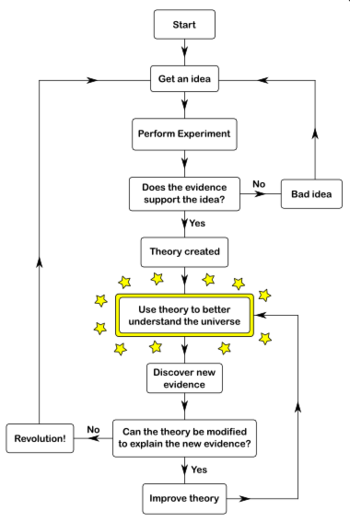Scientific theory
In everyday speech, the word "theory" is used as a "best guess". In modern science, a scientific theory is a tested and expanded hypothesis that explains many experiments. It fits ideas together in a framework. If anyone finds a case where all or part of a scientific theory is false, then that theory is either changed or thrown out.
An example of a scientific theory that underwent many changes is the germ theory of disease. In ancient times, people believed that diseases were caused by the gods, or by curses, or by improper behavior. Germs (microorganisms) were unknown, because germs are too small to see. With the invention of the microscope, germs were discovered, and the germ theory of disease was proposed. Thanks to the germ theory of disease, many diseases can now be cured. However, the germ theory of disease had to be modified, because some diseases are not caused by germs. The flu and scurvy are examples of diseases that are not caused by bacteria, but viruses or poor nutrition. Scientists modified the germ theory of disease, so that today we would state that theory as "Some diseases are caused by germs".
To be a scientific theory, a theory must be tested a large number of times, by different scientists in different places, and must pass the test every time. The theory must be stated exactly, sometimes using mathematics. And it must fit in with all of the other scientific theories. Science has many branches. Physics, chemistry, biology, geology, and astronomy are some of the major branches of science. A scientific theory in one branch of science must hold true in all of the other branches of science. For example, the atomic theory of matter, that all matter is made up of atoms, was discovered using physics, but the chemicals used in chemistry, the living tissue used in biology, the rocks studied in geology, and the planets studied in astronomy are all made up of atoms. The atomic theory of matter holds in every area of science.
Sometimes scientists come up with a theory that is wrong. The discovery of an exception to a scientific theory is a major event, and a scientist can become famous by discovering an exception to a rule. Einstein became famous for his theory of relativity, which found an exception to Isaac Newton's laws of motion. Newton's theory, which had been accepted for hundreds of years, had to be changed, and has been changed.
Here is a list of some of the major theories of modern science. These theories have been tested thousands of times, and no exception has been found.
- The atomic theory of matter: all matter is made up of atoms.
- The law of conservation of mass and energy: in chemical and physical reactions, mass and energy stay the same, in atomic reactions, mass is changed to energy or energy to mass according to the formula E = mc2.
- The cell theory of living things: all living things are made up of cells.
- The tectonic theory of geology: the surface of the earth is composed of tectonic plates, which move slowly.
- The periodic table of elements: atoms are distinguished by their atomic number and atomic weight, and can be arranged in a table which illustrates their properties.
- The theory of relativity: scientific laws hold in different frames of reference.
- Quantum theory: the smallest amount of energy is a "quantum unit", and all energy comes in multiples of this amount.
- The theory of evolution: It explains how living things changed over a long time, and how they have come to be the way they are.
Scientific Theory Media
The first observation of cells, by Robert Hooke, using an early microscope. This led to the development of cell theory.
In quantum mechanics, the electrons of an atom occupy orbitals around the nucleus. This image shows the orbitals of a hydrogen atom (s, p, d) at three different energy levels (1, 2, 3). Brighter areas correspond to higher probability density.
Precession of the perihelion of Mercury (exaggerated). The deviation in Mercury's position from the Newtonian prediction is about 43 arc-seconds (about two-thirds of 1/60 of a degree) per century.
